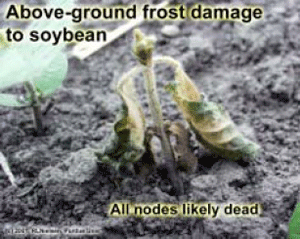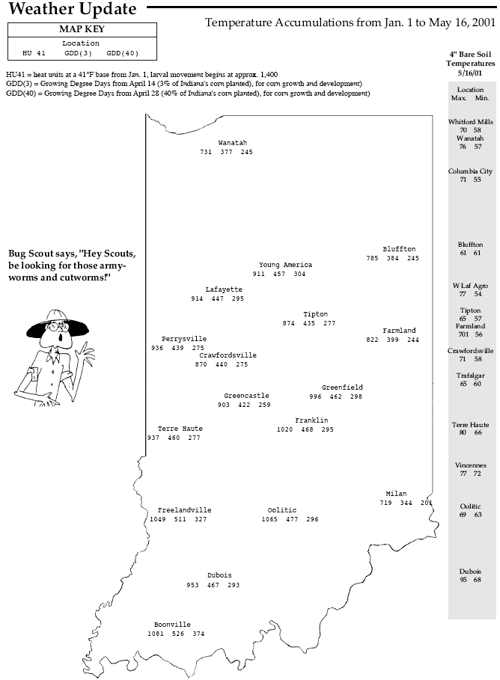Pest & Crop Newsletter
|
||||||||||||||||||||||
Armyworms Marching Big Time, This is NO Parade– (John Obermeyer, Rich Edwards, and Larry Bledsoe)
Thanks to many Purdue extension educators (Jerry Nelson, Bob Yoder, Jim Peters, and Phil Schmidt) and Grower’s Co-op (Chad Brown and Betsy Smith) for alerting us to the armyworm situation in southwestern Indiana. Upon visiting this area, the damage seen in many fields will leave a lasting impression. Wheat, grass pastures, soybean fields, and lawns were observed with devastating damage. It certainly gives one an appreciation for the biotic potential of this insect. At present (Tuesday, May 16) damage has not been reported north of Greene County. It may be just a matter of time, as the armyworm development moves further into the state. Please let us know what you are seeing. We have been asked by several producers on why the “biblical” proportion of armyworm numbers. Simply, there is not a good answer. The facts are that three weeks ago our black light traps picked up impressive numbers of adults (a high of 670 moths in Whitley County). This certainly set the stage for tremendous egg laying. The continual dry conditions, especially apparent in southern Indiana, hasn’t allowed for fungal pathogens to multiply and spread throughout the armyworm population. As well, the damage is aggravated with the stressed crops growing slowly. Parasitic flies have had very little impact, during our inspections only one parasitized larva was observed (white eggs on the worm’s body). High risk crops are those associated with tall growing grasses, e.g., wheat, rye, fescue, etc. Egg laden female moths were attracted to these sites for laying. The newly hatched larvae are very small and damage is negligible. Then, what seems like overnight, the armyworm are 1/2 to 1 inch long and devouring crops; especially where grasses are burned down with herbicides leaving only the emerging crop. When green leaf material gets scarce they move, often in mass, to the adjoining fields. With numbers like those observed in southwestern Indiana, economic thresholds are quickly reached if not exceeded (thresholds for corn and wheat are in the last two issues of the Pest&Crop). See the following table for suggested insecticides.
|
||||||||||||||||||||||
Help Us Welcome Aboard a New Extension Weed Scientist– (Case Medlin and Tom Bauman) The weed science team at Purdue has increased its numbers by one. This week Glenn Nice started his 100% extension appointment in the Department of Botany and Plant Pathology. Glenn, Tom Bauman, and I will coordinate the weed science extension effort so that we can better serve you through our activities including; the Pest&Crop weekly newsletters, the Crop Diagnostic Training and Research Center, the Plant & Pest Diagnostic Lab, winter meetings, and responding to phone calls. Glenn is a native of Winnipeg Canada where he received his BS in Biology from the University of Winnipeg in 1995. In 1996, Glenn started his MS in Weed Science at Mississippi State University (T.J., we’re still out-numbered, but we’re gainin on ‘em!). During the next three years, Glenn evaluated various chemical and cultural weed control methods for use in soybean, corn, and cotton. Upon completion of his degree in 1999, Glenn accepted a Research Assistant position at the North Mississippi Research and Extension Center near Verona, MS. This new position allowed him to become more involved in the extension effort of the Mississippi State system. Tom and I expect great things from Glenn and gladly welcome him aboard.
What to Expect from Your Soil-Applied Herbicide Program– (Tom Bauman, Case Medlin, Mike White and Glenn Nice) Who forgot to pay the water bill?!?! (It must have been Jordan. Who better to blame.) Until this week, much on Indiana has been without any measurable rainfall since the middle of April. Luckily northeastern and southern Indiana has been getting a few rains, but the rest of us are struggling. Over the past week some people have asked, “What will the lack of rainfall do to weed control with my soil-applied herbicide program?” As you know, soil-applied herbicides need an activating rainfall to be effective. For shoot-absorbed herbicides, (Dual II, Degree, Harness, Outlook, Frontier, TopNotch, etc.), the herbicide must be in soil solution when weeds germinate. Since these products are not root absorbed, rainfall after weed emergence will not help to control emerged weeds, but will help prevent future weed flushes. Root-absorbing herbicides (atrazine, Prowl, Treflan, Balance Pro, Canopy XL, Command, etc) also need to be in soil solution to be taken up by the weeds, but not necessarily at the time of weed germination. If activating rainfall (1) occurs soon after emergence, and (2) is enough to wash the herbicide into the root zone, these products can still provide effective control of emerged weeds and help control future weed flushes. We anticipate that postemergence products will be used earlier than usual this year due to lack of rainfall. This coupled with windy conditions could result in many drift problems. You should be particularly careful with herbicides that contain 2,4-D, dicamba, or glyphosate, and do what you can to reduce drift and your liability. Your neighbors will appreciate it!
|
||||||||||||||||||||||
Growing Points of Interest– (Bob Nielsen)
There is something about the rumble of thunder, sheets of driving rain and a few hailstones that makes one curious about the ability of corn to recover from early season damage. When corn is damaged early in the growing season, growers are sometimes faced with the decision of whether or not to replant the field. One of the most important, and most difficult, steps in making a replant decision is estimating the surviving plant population in the field. Corn is remarkably resilient to above-ground damage early in the season, yet growers often underestimate the recovery potential of a damaged corn field. As a result, much replanting is unnecessarily performed each year. Use my replant publication (AY-264) to estimate yield and dollar returns to corn replanting. The health and condition of the corn plant’s growing point region plays a major role in determining whether a damaged corn plant will recover or not. A damaged plant with a healthy, undamaged growing point (apical meristem) will survive. Damage to the growing point area will either kill the plant or severely stunt its recovery. Corn’s growing point is initially located 1/4 to 3/4 inch below the soil surface, near the crown. The growing point remains below ground until about V6. The stalk internodes begin to elongate shortly before growth stage V6, rapidly elevating the growing point above soil surface. From this point on, the growing point becomes increasingly vulnerable to above-ground damage. Prior to V6, a plant is relatively immune to above-ground damage from ‘single event’ damage by frost, hail, cutworm, sandblasting, anhydrous ammonia burn, 28% N solution burn, and paraquat drift. However, repeated injury to young plants may stunt a plant’s development severely enough to eventually kill the plant even though the growing point was technically not injured. While corn younger than V6 can tolerate a fair degree of above-ground damage to leaf tissue by frost, lethal cold temperatures (32°F or less for several hours) can ‘penetrate’ the upper soil surface and damage or kill the growing point of a young corn plant. Corn younger than V6 is also susceptible to below-ground damage from soil insects, disease and flooding. Damaged corn fields need to be left alone for several days after the damage occurs to give them some time to initiate recovery. Recovery from the whorl will appear within 3 to 10 days, depending on temperature and soil moisture. Warmer temperatures and adequate soil moisture encourage rapid recovery, while cooler temperatures and/or drought stress restrict the rate of recovery. The stalk tissue near the growing point region should remain firm and yellowish-white. Injury occurring close to the growing point may alter normal hormonal activity and cause deformed regrowth. Given sufficient time, surviving corn plants should be showing new leaf tissue expanding from the whorls, while dead corn plants will still look dead. Don’t forget, this and other timely information about corn can be viewed at the Chat ‘n Chew Café on the World Wide Web at <http://www.kingcorn.org/chatchew.htm>. For other information about corn, take a look at the Corn Growers’ Guidebook on the World Wide Web at <http://www.kingcorn.org/>.
|
||||||||||||||||||||||
|
||||||||||||||||||||||












